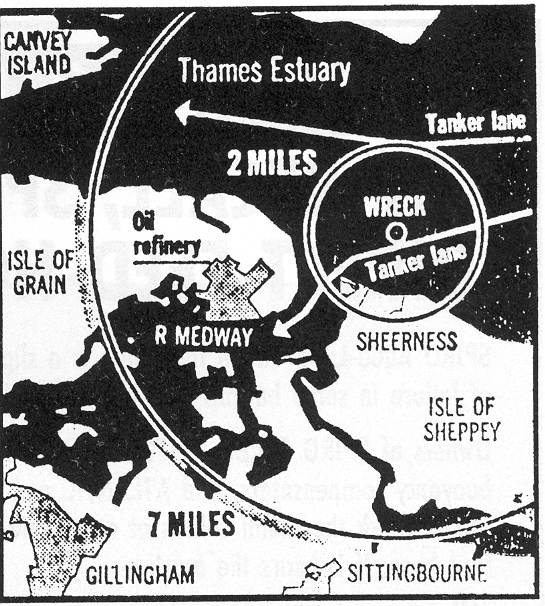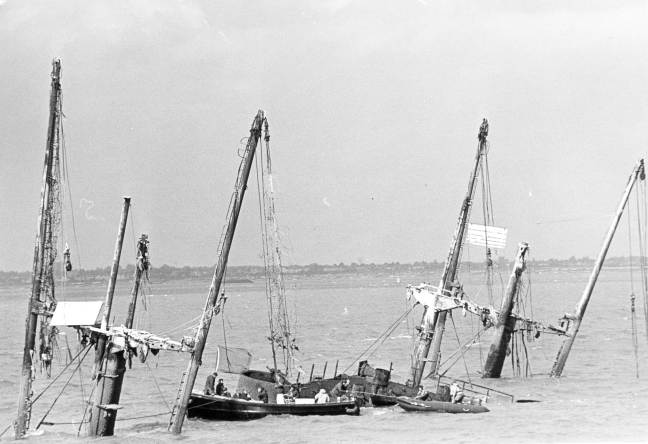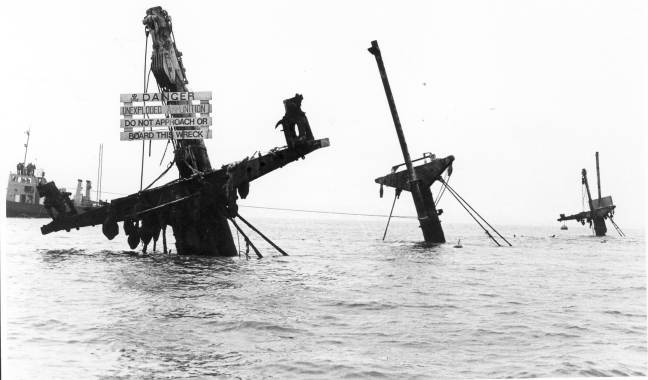
The BBC has called it the “ticking time bomb of the Thames,” and The New Scientist has referred to it as “The Doomsday Wreck,” yet very few people seem to know about the danger that lurks beneath the waves in the Thames estuary.
During a gale back in 1944 the cargo ship SS Richard Montgomery sank while at anchor off the Nore sandbank in the Thames Estuary, near Sheerness,
The 129 metre long ship was an American Liberty ship built by the St. Johns River Shipbuilding Company in Florida during World War II. She was one of the 2,710 similarly built ships used to carry cargo during the war.
Ticking time bomb
in August 1944 loaded with 6,225 tonnes of high-explosive cargo she arrived in the Thames estuary and was instructed her to moor at Sheerness middle sands in about 10 metres of water. Possibly this was unwise, given the fully laden vessels draught was 9.45.

On Sunday 20 August 1944 she dragged her anchor and ran aground. As the tide ebbed away, her plates began to buckle and crack. Four days later a cargo hold was breached, and two weeks later the ship broke her back. Salvage took place over the next month, with much of the ammunition removed. But then operations were abandoned when it became too dangerous to continue.
She remains where she sank and at certain states of the tide the ship’s cargo handling equipment can be clearly seen by passing marine traffic.
On board the remaining cargo of ammunition continues to be a threat with 9,000 shells, bombs and other high explosives still believed to be inside the ship’s holds. Although how much there is on board differs greatly depending on what documents one reads while doing research
What to do with the wreck
The question has always been: What to do with the wreck of the Montgomery? Leave well alone and hope for the best or attempt to defuse the situation and hope it does not go wrong while doing so.
The wreck represents a danger to everyone in and around London. In 1970 the Royal Military College of Science warned in that if the remaining cargo on board blew up, the force of the explosion would create a 3,000 metre-high column of water and a five metre high tidal wave would swamp Sheerness and its 11,000 residents. That same tidal surge would then travel up the Thames and damage waterfront properties docks and moorings.

The risks of trying to remove the cargo have, in the past, been too great to consider. Experts feared that trying to remove the cargo could prove too dangerous to consider. Yet time, tide and the elements continue to eat away at the structure of the wreck meaning that the longer it stays there the more dangerous the ships presence is
These worries are not unfounded. In 1967 during the process of removing high explosives off a much small ship which sank in similar circumstances off the coast of Folkstone near Dover proved disastrous. Despite being 4 miles off the coast the town of Folkstone was rocked by an explosion which measured 4.4 on the Richter Scale when it blew up. Property was damaged but fortunately no one was hurt when the operation went wrong and the ship and her cargo blew up
Prank
In 1969, as a prank, students from Kent University phoned the police threatening to blow the Montgomery up. Not surprisingly, that led to a massive security operation. A similar operation was mounted during the 2012 Olympics when, according to one source, a speedboat carrying three men and explosives was intercepted nearby.
But now 75 years after Montgomery sank the UK government may be considering new means to keep the wreck safe.
Kent Online, part of the KM Media Group, is reporting that in the House of Lords Baroness Barran has said: “An advisory group of experts is considering whether monitoring and regular surveying is still the correct course or whether a more proactive intervention should be considered. Interventions could include the removal of munitions or some form of containment of the wreck. We appreciate there are no risk-free options which is why we are using the most qualified experts we can find.”
